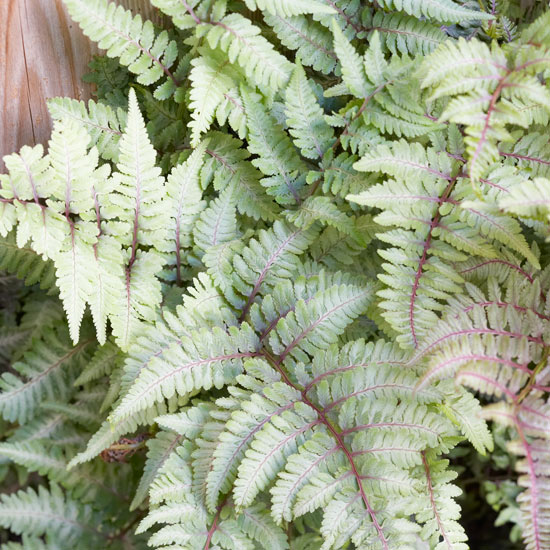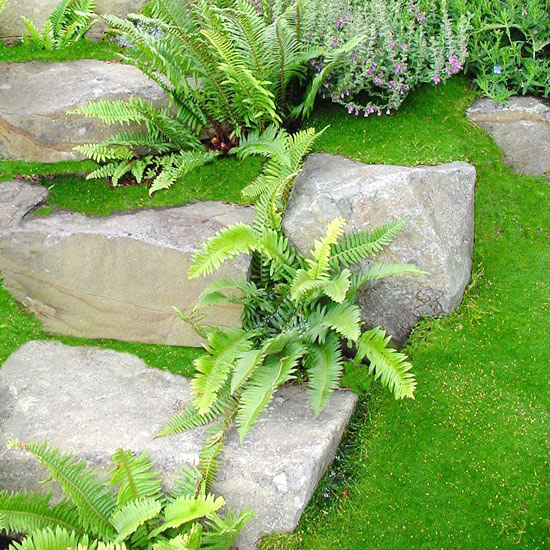






If you have lots of shade but there are too many deer in your neighborhood to grow hostas and other perennial plants, rely on ferns to deliver welcome color and texture, especially when blended with other flowers. Many are natives, and they come in a startlingly wide variety of colors, shapes, and sizes.
Ferns are part of an ancient group of plants, including mosses and liverworts, that dates back about 300 million years -- before the dinosaurs!
As you may guess from a plant that old, they're easy to grow and there's a fern suitable for almost any location. Hardiness varies by species.
How to Grow Fern Plants in Your Garden
Plant ferns in part to full shade and rich, well-drained soil. In all climates, they need protection from afternoon sun to prevent drying and leaf scorch.
Ferns can reach 12 inches to 6 feet tall, depending on the type and growing conditions. The plant prefers rich, humus-filled soil. Mix compost into planting holes and cover them annually with 2 inches of composted oak leaves or other organic mulch to keep them fed and moistened.
Like other perennial plants, you can divide ferns in spring or fall. Keep the divisions well-watered until plants are established.
Some ferns spread by underground runners -- helpful in places where you want to plant a groundcover, but unwelcome in an orderly, formal planting. Research the characteristics of each fern before you plant it.
Ferns are ideal companions in a woodland garden, where they offer a texture change when planted with other perennials. Other deer-resistant companions include astilbe, hellebore, barrenwort, and heart-leaf brunnera.
Learn more about dividing perennials.

Holly Fern
Holly ferns (Polystichum spp.), native to the eastern United States, get their common name because their tough green leaves often persist through winter so they can be cut for Christmas decorations, making them valuable garden plants. Clip last year's leaves off the plants in early spring before new growth appears.
Learn more about holly fern.
Western Sword Fern
Western sword ferns (P. munitum) thrive in coastal settings and grow glossy deep green fronds 3-4 feet tall and wide. Zones 5-10
Japajnese Tassel Fern
Japanese tassel ferns (P. polyblepharum) are shorter, 18-24 inches tall and 10 inches wide. They do well in containers. Zones 6-10
Hay-Scented Fern
Native to the eastern United States, arching yellow-green fronds of this fern (Dennstaedtia punctilobula) have the distinction of smelling like freshly mown hay when bruised or crushed. The plants, 3 feet tall and wide, quickly spread as a groundcover. Zones 3-8
Learn more about hay-scented fern.
Lady Fern
Lady ferns (Athyrium spp.) live up to their name -- they are both beautiful and dainty. These ferns vary greatly in size and structure. Some are strongly upright; others are spreading. Lady ferns are relatively tolerant of sun and dry soil and drop their leaves in fall.
Three showy cultivars to plant in your garden are Japanese painted fern (A. niponicum pictum), the 2004 Perennial Plant of the Year; Athyrium 'Ghost'; and 'Lady in Red' lady fern (A. filix-femina 'Lady in Red').
Japanese painted ferns unfurl silver fronds brushed with red and blue tints on burgundy stems. They reach 12-18 inches tall and 24 inches wide. The silvery foliage achieves its best color when it gets a few hours of morning sunshine. Zones 4-9
The variety 'Ghost' is more upright than the Japanese painted fern but has the same silvery foliage. It reaches 1-3 feet tall and wide. Zones 3-8
'Lady in Red' lady fern is a cross between Japanese painted fern and Southern lady fern. It grows with a strongly vertical form, showcasing its brilliant red-violet stems and lacy, light green foliage. It reaches 20-24 inches tall and 3 feet wide. Zones 3-8
There are many other lady ferns that make fine garden plants, each with interesting qualities, including the crested lady fern (A. filix-femina 'Cristatum') with frilly double edges on each leaf.
Learn more about Japanese painted ferns.
Maidenhair Fern
The delicate, airy look of maidenhair ferns (Adiantum spp.) belies how tough these plants really are. Each wiry stem holds broad leaflets at the tip of the stem, creating an umbrellalike appearance. These noninvasive ferns look good planted together in a group.
Northern maidenhair fern (A. pedatum aleuticum) grows 24-inch black-purple stems topped with arching branchlets arranged like fingers on a hand. The straight species is beautiful as well as its variations, such as 'Miss Sharples' (light yellow-green new growth) and 'Japonicum' (pinkish-bronze new growth). Zones 5-8
Southern maidenhair fern (A. capillus-venerus) is a native southerner. It thrives in heat and humidity and requires consistently moist soil. Bright green fronds grow on blackish stems 18-24 inches tall. Zones 7-10
Learn more about maidenhair ferns.
Osmunda Ferns
Osmunda ferns are among the largest ferns home gardens can plant. Native everywhere east of the Mississippi and a few places to the west, they thrive in very moist soil.
Cinnamon fern (O. cinnamomea) takes its name from the erect, 36-inch-tall, reddish-brown spore-bearing fronds that grow in the center of light green fronds that can reach 5 feet tall in a 24-inch-wide clump. Grow these tough deciduous beauties at the edge of ponds or in informal woodlands. Zones 4-9
Interrupted fern (O. claytoniana) takes its common name from brown fertile leaflets that appear to interrupt green sterile leaflets on larger fronds. At 3 feet tall and 6 feet wide, this large garden presence is deciduous in the fall. Zones 3-6
Learn more about cinnamon fern.
Ostrich Fern
If you want a plant to take over a wet woodland space, choose ostrich fern (Matteuccia struthiopteris). These large, vase-shape ferns unfurl fronds that can reach 5 feet, although 3 feet tall and wide is typical. The green fronds resemble ostrich plumes. Do not plant this fern with well-behaved perennials or other tidy plants; it will quickly bully them. With space to roam and average to moist soil, they quickly make a junglelike groundcover. Ostrich ferns tolerate sun as long as the soil never dries. When soil dries in shady locations, however, fronds burn. Zones 3-8
Learn more about ostrich fern.
Wood Fern
Tough, beautiful, and drought-tolerant once established, wood ferns (Dryopteris spp.) are great for planting in the garden. Some types of these medium-size ferns are evergreen plants while others drop their leaves in fall. Divide the clumps every three years or so to maintain their symmetrical forms. Undivided clumps become large and unattractive.
Autumn fern (D. erythrosora) opens in spring with coppery fronds, 18 inches tall and wide, that shift to green in summer, then provide rust-color in fall. Consider 'Brilliance' for brighter red new growth.
Marginal wood fern (D. marginalis) is a native of rocky woodland slopes typically forming a vase-shape clump 18 inches tall and 2 feet wide. Zones 3-8
Learn more about wood fern.
Copyright © www.100flowers.win Botanic Garden All Rights Reserved